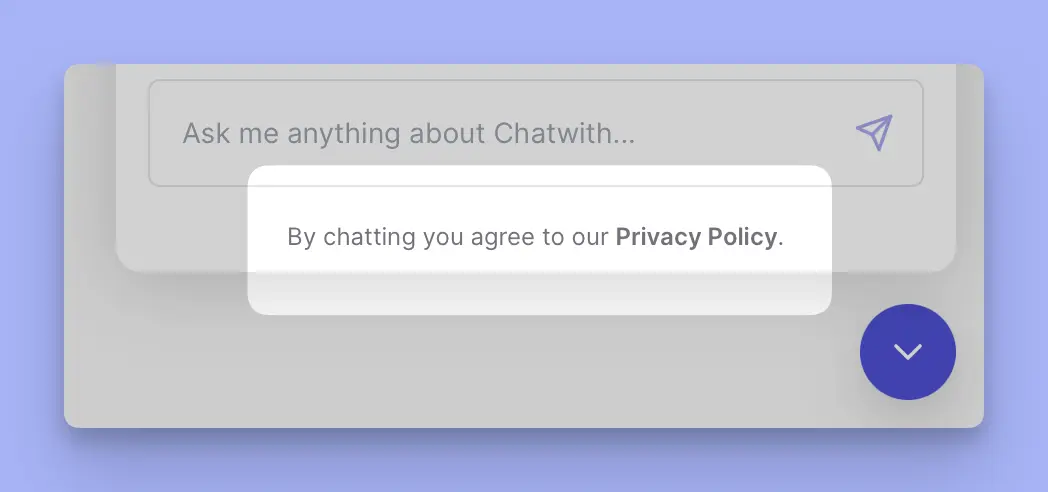
Founder of Chatwith
Chatwith is GDPR compliant. A guide for chatbot owners.
I am excited to share that Chatwith is fully GDPR compliant! This is a big step for us in making sure your & your customers' data is protected and privacy is respected. Here’s what you need to know if you're using Chatwith chatbots.
What is GDPR, anyways?
The General Data Protection Regulation (GDPR) is a law from the European Union that focuses on protecting personal data and privacy. It gives people more control over their personal information and sets rules for how companies should handle this data.
Why is GDPR compliance important?
- Better data security: Being GDPR compliant means the use of strong security measures to keep customers' data safe.
- Transparency and control: A clear explanation of how data is collected, used, and shared with the right to access, correct and delete it.
- Not complying can be costly: It could lead to substantial penalties, reaching up to 20 million euros or 4% of your worldwide turnover for the preceding financial year – whichever is higher.
What is considered personal data?
Under the GDPR, personal data is defined as “any information that relates to an identified or identifiable living individual.” This includes:
- Telephone numbers
- Credit card numbers
- Personnel numbers
- Account data
- Number plates
- Appearance
- Customer numbers
- Addresses
However, the definition under the GDPR is broad – if you’re unsure whether information should count as personal data, you’re better off assuming it should be handled as such.
How Chatwith ensures GDPR compliance
We have put in place all the necessary steps to meet GDPR standards. Here’s how we’ve made sure our chatbot service is GDPR compliant:
- List of Subprocessors: We use certain third-party services to help us deliver our chatbot service. You can see the list of these subprocessors here: https://chatwith.tools/legal/subprocessors
- Data Processing Agreement (DPA): We provide a DPA that explains how we handle personal data. It part of our Terms of Use, so there’s no extra signing needed.
- User rights management: Our platform includes tools that help you manage collected data (ie. delete leads and conversations).
- Security measures: We use advanced security techniques like encryption and access controls to protect your data.
Tips for GDPR compliance when using Chatwith chatbots
Here are some easy tips to help you stay GDPR compliant when you use our chatbots in your business:
1. Update your Privacy Policy
Mention that you use Chatwith for your chatbot service. Explain what data is collected, how it’s used, and what rights your users have.
Example Privacy Policy update:
We use Chatwith to provide chatbot services on our website. This chatbot collects and processes personal data such as chat logs and user interactions. Chatwith operates under strict GDPR compliance and processes data according to our instructions. For more information, please refer to Chatwith's privacy policy at https://chatwith.tools/privacy.
2. Get consent
Make sure your users agree to data collection through the chatbot by using a popup or footer that links to your Privacy Policy and explains what data is collected and why.

3. Enable user rights management
If your chatbot collects personal information (eg. in the form of leads, surveys etc) and is exported outside of Chatwith, provide a way to manage it. Allow users to easily access, correct, or delete their data.
4. Ensure data security
Use secure methods for transmitting and storing personal data. Chatwith uses encryption and regular security checks to keep data safe. If you export user data out of Chatwith (eg. using Actions, conversation exports etc.) make sure you handle your customer data in a secure manner.
5. Regularly review your compliance
Keep up-to-date with GDPR requirements and review your compliance practices regularly. Update your privacy policy and data handling methods as needed.
Building compliant chatbots
Making sure your chatbot adheres to GDPR is crucial not only for legal and financial integrity but also for maintaining user trust. By following the tips we shared, you can ensure that your Chatwith chatbots operate within GDPR compliance, giving your users a secure and trustworthy experience.
For any questions, you can reach out at support@chatwith.tools.
More from our blog
Engagement boost with search powered by custom AI chatbot
Learn how PoweredbyAI has increased user engagement by creating a custom AI chatbot that connects to their API and helps visitors find AI products.
Tips for creating a custom GPT with Actions and OpenAPI
In this guide, we will share how to create capable, functional and safe experiences using custom ChatGPT chatbots with Actions enabled using OpenAPI.

